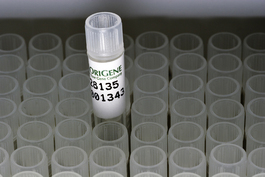MKRN1 (NM_001291663) Human Untagged Clone
CAT#: SC334925
MKRN1 (untagged) - Human makorin ring finger protein 1 (MKRN1), transcript variant 3
"NM_001291663" in other vectors (1)
Product Images

Specifications
| Product Data | |
| Type | Human Untagged Clone |
| Tag | Tag Free |
| Symbol | MKRN1 |
| Synonyms | RNF61 |
| Vector | pCMV6-Entry |
| E. coli Selection | Kanamycin (25 ug/mL) |
| Mammalian Cell Selection | Neomycin |
| Sequence Data |
>SC334925 representing NM_001291663.
Blue=Insert sequence Red=Cloning site Green=Tag(s) GCTCGTTTAGTGAACCGTCAGAATTTTGTAATACGACTCACTATAGGGCGGCCGGGAATTCGTCGACTG GATCCGGTACCGAGGAGATCTGCCGCCGCGATCGCC ATGCATGGGGTTTGTAAGGAAGGAGACAACTGTCGCTACTCGCATGACCTCTCTGACAGTCCGTATAGT GTAGTGTGCAAGTATTTTCAGCGAGGGTACTGTATTTATGGAGACCGCTGCAGATATGAACATAGCAAA CCATTGAAACAGGAAGAAGCAACTGCTACAGAGCTAACTACAAAGTCATCCCTTGCTGCTTCCTCAAGT CTCTCATCGATAGTTGGACCACTTGTTGAAATGAATACAGGCGAAGCTGAGTCAAGAAATTCAAACTTT GCAACTGTAGGAGCAGGTTCAGAGGACTGGGTGAATGCTATTGAGTTTGTTCCTGGGCAACCCTACTGT GGCCGTACTGCGCCTTCCTGCACTGAAGCACCCCTGCAGGGCTCAGTGACCAAGGAAGAATCAGAGAAA GAGCAAACCGCCGTGGAGACAAAGAAGCAGCTGTGCCCCTATGCTGCAGTGGGAGAGTGCCGATACGGG GAGAACTGTGTGTATCTCCACGGAGATTCTTGTGACATGTGTGGGCTGCAGGTCCTGCATCCAATGGAT GCTGCCCAGAGATCGCAGCATATCAAATCGTGCATTGAGGCCCATGAGAAGGACATGGAGCTCTCATTT GCCGTGCAGCGCAGCAAGGACATGGTGTGTGGGATCTGCATGGAGGTGGTCTATGAGAAAGCCAACCCC AGTGAGCGCCGCTTCGGGATCCTCTCCAACTGCAACCACACCTACTGTCTCAAGTGCATTCGCAAGTGG AGGAGTGCTAAGCAATTTGAGAGCAAGATCATAAAGTGA ACGCGTACGCGGCCGCTCGAGCAGAAACTCATCTCAGAAGAGGATCTGGCAGCAAATGATATCCTGGAT TACAAGGATGACGACGATAAGGTTTAAACGGCCGGC |
| Restriction Sites |
SgfI-MluI
Plasmid Map

|
| ACCN | NM_001291663 |
| Insert Size | 798 bp |
| OTI Disclaimer | Our molecular clone sequence data has been matched to the reference identifier above as a point of reference. Note that the complete sequence of our molecular clones may differ from the sequence published for this corresponding reference, e.g., by representing an alternative RNA splicing form or single nucleotide polymorphism (SNP). |
| Product Components | The ORF clone is ion-exchange column purified and shipped in a 2D barcoded Matrix tube containing 10ug of transfection-ready, dried plasmid DNA (reconstitute with 100 ul of water). |
| Reconstitution | 1. Centrifuge at 5,000xg for 5min. 2. Carefully open the tube and add 100ul of sterile water to dissolve the DNA. 3. Close the tube and incubate for 10 minutes at room temperature. 4. Briefly vortex the tube and then do a quick spin (less than 5000xg) to concentrate the liquid at the bottom. 5. Store the suspended plasmid at -20°C. The DNA is stable for at least one year from date of shipping when stored at -20°C. |
| Reference Data | |
| RefSeq | NM_001291663.1 |
| RefSeq Size | 1848 bp |
| RefSeq ORF | 798 bp |
| Locus ID | 23608 |
| Cytogenetics | 7q34 |
| Protein Families | Druggable Genome |
| MW | 29.5 kDa |
| Gene Summary | This gene encodes a protein that belongs to a novel class of zinc finger proteins. The encoded protein functions as a transcriptional co-regulator, and as an E3 ubiquitin ligase that promotes the ubiquitination and proteasomal degradation of target proteins. The protein encoded by this gene is thought to regulate RNA polymerase II-catalyzed transcription. Substrates for this protein's E3 ubiquitin ligase activity include the capsid protein of the West Nile virus and the catalytic subunit of the telomerase ribonucleoprotein. This protein controls cell cycle arrest and apoptosis by regulating p21, a cell cycle regulator, and the tumor suppressor protein p53. Pseudogenes of this gene are present on chromosomes 1, 3, 9, 12 and 20, and on the X chromosome. Alternative splicing results in multiple transcript variants encoding different isoforms. [provided by RefSeq, Apr 2014] Transcript Variant: This variant (3) has multiple differences compared to variant 1. These differences result in distinct 5' and 3' UTRs and cause translation initiation at a downstream start codon compared to variant 1. The 5'-most initiation codon, as used in variant 1, is associated with a truncated ORF that would render the transcript a candidate for nonsense-mediated decay (NMD). Leaky scanning may allow translation initiation at the downstream AUG to encode an isoform (3) that has a shorter N-terminus, and a distinct C-terminus, compared to isoform 1. |
Documents
| Product Manuals |
| FAQs |
| SDS |
Resources
Other Versions
| SKU | Description | Size | Price |
|---|---|---|---|
| RC237031 | MKRN1 (myc-DDK-tagged) - Human makorin ring finger protein 1 (MKRN1), transcript variant 3 |
USD 420.00 |
{0} Product Review(s)
Be the first one to submit a review






























































































































































































































































 Germany
Germany
 Japan
Japan
 United Kingdom
United Kingdom
 China
China
